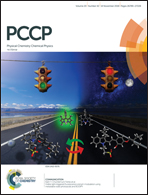Proton transfer triggered proton transfer: a self-assisted twin excited state intramolecular proton transfer†‡
Abstract
The double excited state intramolecular proton transfer (ESIPT) of 3,5-bis(2-hydroxyphenyl)-1H-1,2,4-triazole (bis-HPTA), a molecule possessing two intramolecular hydrogen bonded donor–acceptor pairs, has been investigated. The molecule undergoes not only a single ESIPT, but also a rare twin ESIPT. The most interesting fact is that initially, only one acid–base pair is ESIPT active and the other pair is ESIPT inactive. The first proton transfer triggers the proton transfer in the second acid–base pair by creating appropriate conditions. This new type of sequential proton transfer is labeled as ‘proton transfer triggered proton transfer’ (PTTPT). The PTTPT has been demonstrated by steady state and time resolved fluorescence techniques. It was further substantiated by theoretical data and using a chemically modified system 3-(2-hydroxyphenyl)-5-(2-methoxyphenyl)-1H-1,2,4-triazole.



 Please wait while we load your content...
Please wait while we load your content...